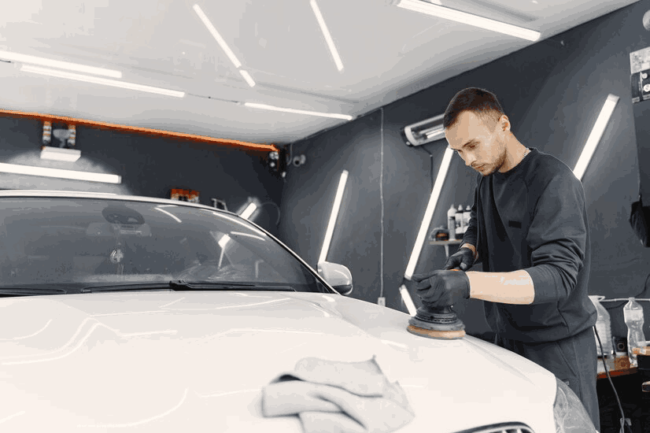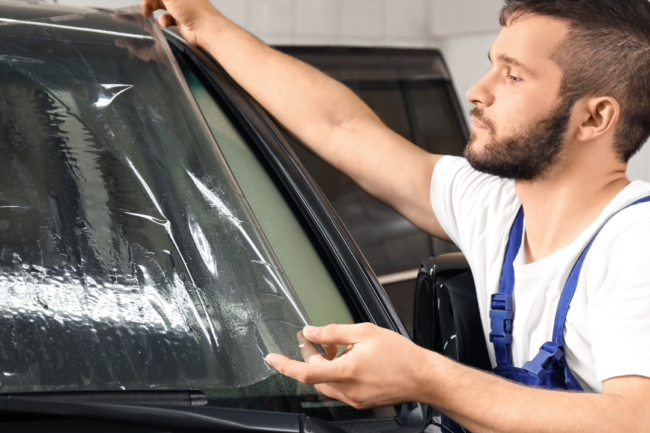In the high-stakes world of competitive racing, every fraction of a second matters, and the pursuit of optimal performance and durability is relentless. Enter ceramic coating, a cutting-edge solution that has rapidly gained traction in the race car industry for its transformative effects on both speed and protection. This advanced technology, originally developed for aerospace applications, has seamlessly transitioned into the realm of motorsports, offering a unique combination of enhanced aerodynamics and formidable shield against the punishing conditions of the track.
Ceramic coatings boast a remarkable ability to reduce drag, optimizing a race car’s aerodynamic profile. By applying a thin layer of ceramic material to the vehicle’s exterior, the coating smoothens surface irregularities, minimizing air resistance and promoting streamlined airflow. This results in improved speed and fuel efficiency, crucial factors that can make all the difference in a fiercely contested race. Beyond its impact on performance, ceramic coatings also act as a formidable protective barrier, shielding race cars from the intense heat, corrosive chemicals, and abrasive debris encountered during high-speed competitions. As the demand for peak efficiency and longevity continues to surge in the racing world, the adoption of ceramic coatings stands as a testament to the industry’s unyielding commitment to pushing boundaries and embracing innovations that redefine the dynamics of speed and endurance.
The Science Behind Ceramic Coating
In the realm of ceramic coatings, the intricate dance between science and engineering unfolds with precision and purpose. At its core, the technology relies on cutting-edge nanotechnology, where minuscule ceramic particles become the architects of improved race car performance. These microscopic particles, meticulously designed and engineered, engage in a symbiotic relationship with the race car’s surface. Through a process that transcends the naked eye, they form an imperceptibly thin layer, creating a molecular bond that goes beyond the superficial.
Delving into the intricate chemistry and physics of ceramic coatings unveils a fascinating world where the manipulation of materials occurs at the nanoscale. The bonding mechanism not only fortifies the surface but also contributes to the coating’s remarkable ability to reduce drag and optimize aerodynamics. This dynamic interplay of particles and forces transforms ceramic coatings into a precision tool for race car engineers, offering a nuanced solution that transcends traditional approaches. As we explore this microcosm of technological prowess, it becomes evident that the effectiveness of ceramic coatings is rooted in the meticulous fusion of science and engineering, propelling race cars into a realm of optimized speed and performance.
Aerodynamic Advantages: Breaking Down Drag Reduction
In the high-stakes world of racing, the quest for optimal aerodynamics stands as a pivotal factor in achieving peak performance. Ceramic coatings emerge as a game-changing solution, revolutionizing the dynamics of drag reduction. The seamless application of ceramic coatings to a race car’s surface introduces a host of aerodynamic advantages that significantly enhance its overall performance on the track.
 Streamlined Airflow: Ceramic coatings act as a catalyst for streamlined airflow, reducing surface irregularities that contribute to drag. This, in turn, allows race cars to cut through the air with increased efficiency.
Streamlined Airflow: Ceramic coatings act as a catalyst for streamlined airflow, reducing surface irregularities that contribute to drag. This, in turn, allows race cars to cut through the air with increased efficiency.- Improved Efficiency: By minimizing drag, ceramic coatings optimize the aerodynamic profile of a race car, enabling it to move more effortlessly through the air. This translates into improved efficiency, crucial for achieving higher speeds and better fuel economy.
- Wind Tunnel Validation: Racing teams often employ wind tunnel testing to validate the impact of ceramic coatings on drag reduction. These controlled experiments provide empirical evidence of the coatings’ effectiveness in enhancing aerodynamic performance.
- Enhanced Handling: The reduction in drag not only boosts straight-line speed but also contributes to improved handling, allowing drivers to navigate corners and maneuvers with greater precision.
- Competitive Edge: In a sport where fractions of a second can determine victory, the aerodynamic advantages bestowed by ceramic coatings offer a competitive edge. Racing teams strategically leverage these coatings to gain a performance boost and stay ahead in the fiercely contested world of motorsports.
As racing technology continues to evolve, the role of ceramic coatings in breaking down drag becomes increasingly indispensable, setting new standards for aerodynamic excellence on the race track.
Speed Optimization: Unleashing The Full Potential
Exploring the synergy between ceramic coatings and speed optimization reveals a nuanced relationship that extends beyond drag reduction. These coatings are pivotal in unlocking a race car’s full potential by promoting streamlined airflow, propelling it to unprecedented speeds. This enhanced efficiency not only accelerates the vehicle but also improves fuel economy, providing a crucial competitive edge in the world of motorsports.
From an engineering standpoint, ceramic coatings play a profound role in meticulously optimizing a race car’s aerodynamics. Every contour and imperfection are considered, with ceramic coatings serving as a transformative solution that allows engineers to sculpt a vehicle capable of defying speed limits. The tangible impact unfolds on the track, where thrilling moments showcase the transformative force of ceramic coatings, redefining the essence of speed in the pursuit of victory.
From Aerospace To Asphalt: The Evolution Of Ceramic Technology
In the evolutionary journey from aerospace applications to the asphalt of race tracks, ceramic technology has undergone a transformative metamorphosis, adapting its versatile capabilities to the high-speed demands of competitive racing. Originally crafted for the rigors of space exploration and aircraft engineering, ceramic coatings have seamlessly transitioned into the realm of motorsports. This evolution speaks to the adaptability and effectiveness of ceramic technology in optimizing race car performance and durability.
- Aerospace Origins: Explore how ceramic technology was initially developed for use in space shuttles and aircraft, emphasizing its roots in demanding aerospace applications.
- Material Adaptation: Delve into the adaptability of ceramic materials, showcasing their ability to transition from space exploration to the intense environment of race car engineering.
- Precision Engineering: Highlight the precision and craftsmanship involved in tailoring ceramic technology to meet the specific challenges posed by the asphalt of race tracks.
- Technological Integration: Examine the seamless integration of ceramic coatings into the world of motorsports, emphasizing their critical role in optimizing aerodynamics and protecting race cars from harsh racing conditions.
- Versatility Unleashed: Discuss how the evolution of ceramic technology underscores its versatility, proving to be a dynamic force capable of enhancing performance across diverse and demanding settings.
The evolution from aerospace to asphalt stands as a testament to the enduring relevance and innovative application of ceramic technology, showcasing its capacity to redefine the dynamics of speed and endurance on the race track.
The Battle Against Heat: Ceramic Coatings As Thermal Protectors

Heat is an ever-present adversary on the race track, and ceramic coatings emerge as formidable thermal protectors. Investigate how these coatings act as a robust defense, creating a resilient barrier that shields race cars from the intense heat generated during high-speed competitions. From engine bays to exhaust systems, grasp the comprehensive approach of ceramic coatings in mitigating the detrimental effects of extreme temperatures, ensuring both performance and durability in the relentless heat of the racing environment.
Chemical Resistance: Guarding Against Corrosive Challenges
In the high-stakes world of competitive racing, where speed and endurance are paramount, race cars face a barrage of corrosive challenges that can jeopardize their performance and longevity. The incorporation of ceramic coatings introduces a formidable defense against these corrosive elements, ensuring that race cars remain resilient in the face of chemical adversity. The application of ceramic coatings involves creating a robust shield that guards various components of the race car against detrimental substances encountered on the track.
- Brake Fluid Resistance: Ceramic coatings act as a barrier, protecting crucial brake components from the corrosive effects of brake fluids used during high-performance braking maneuvers.
- Resistance to Cleaning Agents: The coating’s chemical resistance extends to harsh cleaning agents, ensuring that maintenance procedures do not compromise the integrity of the race car’s surfaces.
- Protection from Track Debris: By forming a resilient layer, ceramic coatings guard against corrosive effects from abrasive track debris, preventing long-term damage to the vehicle’s exterior.
- Safeguarding Against Fuel Corrosion: Racing fuels can contain corrosive elements; ceramic coatings provide a shield against fuel-related corrosion, preserving the integrity of the race car’s fuel system.
In essence, the chemical resistance of ceramic coatings emerges as a vital component in the holistic protection of race cars, ensuring they withstand the corrosive challenges inherent in the demanding environment of competitive racing.
Precision Application: How Ceramic Coating is Administered
The application of ceramic coatings is a meticulous process that demands precision. Explore the detailed steps involved, from surface preparation to the actual coating application. Understand the role of skilled technicians and advanced application techniques in ensuring an even and effective coating. Whether through spray application or other methods, delve into the craftsmanship behind the scenes that transforms a race car’s surface into a meticulously coated canvas, ready to harness the full benefits of ceramic technology on the track.
Innovation on the Track: Testimonials from Racing Professionals
Hear the firsthand accounts and testimonials from racing professionals who have experienced the transformative effects of ceramic coatings on the track. From seasoned drivers to expert engineers, gather insights into how these coatings have become integral to their pursuit of excellence in competitive racing. Explore the anecdotes, success stories, and challenges overcome through the adoption of ceramic coatings, offering a compelling narrative that underscores the real-world impact and endorsement of this innovative technology in the high-stakes world of motorsports.
In the fast-paced world of motorsports, where every advantage counts, ceramic coatings have proven to be a transformative force, enhancing both performance and protection for race cars. As we conclude this journey into the science, aerodynamics, and chemical resilience of ceramic coatings, the address for Quality Auto Glass & Tint (4500 Salida Boulevard Suite D-E, Modesto, CA, 95368) stands as a beacon for those eager to experience the benefits firsthand. Contact us at (209) 900-8269 or support@qualityautoglasstint.com, Monday through Saturday, 9 am to 5 pm, and embark on a journey to elevate your race car’s prowess on the track. Unleash the full potential of your vehicle with the precision and durability offered by ceramic coatings. Your triumph on the racing circuit awaits!




